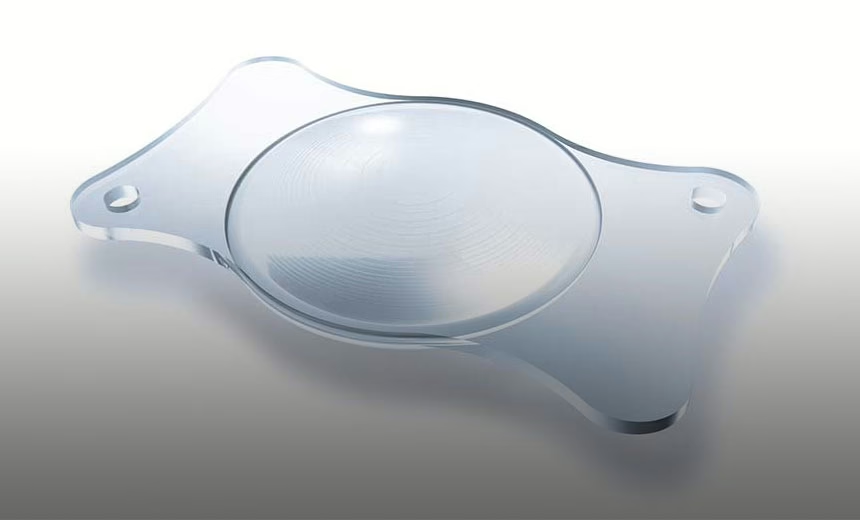Subscribe to eyeMatters periodic news
"*" indicates required fields

Trifocal intraocular lenses

Artificial lens implants have been part of modern eye surgery for many decades. Referred to by surgeons as intraocular lenses (IOLs), these tiny implants replace the natural lens of the eye, which is removed during cataract surgery.
However, these lenses are being used more frequently as a primary vision correction procedure for people in the 55+ age range, as they are less likely to be suitable for laser eye surgery.
Designed to replace the natural focusing power of the eye, early artificial lenses were limited in their ability to adjust vision from one distance to another. Today, lens technology has improved to the point where some over 55-year-olds can be free from glasses.
Lens focus power explained
The job of the eye’s natural lens is to focus on whatever distance a person is looking at – say, from gazing at a clock on a distant wall and then immediately back to a newspaper. If the lens is doing its job properly, this will be a seamless transition.
Somewhere in their late 30s to early 40s, most people find that this focusing mechanism isn’t working as well and that their reading vision is getting blurry. This is a condition called presbyopia.
If the same person has suffered from short-sightedness for the majority of their life, they will have worn glasses or contact lenses for distance vision. Now they’ll need to move to more complex lens solutions, such as bifocals or multifocals, or multiple sets of glasses.
If this person goes on to develop cataracts, they will find that cataract surgery comes with a bonus – the artificial lenses used during surgery can take the place of their usual glasses prescription.
Until recently, artificial lenses used during cataract surgery could correct vision for one distance only. So this same person could have their artificial lens adjusted for one focusing power (usually for distance vision), but still need to pick up reading glasses to see up close.
Then the game started changing.
Multifocal lenses
In recent years, the range of multifocal lenses has increased significantly. These were developed to contain more than one lens power in order to provide a wider range of clear vision – that is, at distance, intermediate and near vision.
However, they weren’t suitable for all patients because they sometimes came with compromises, including less than perfect mid-range (intermediate) vision and the possibility of glare and haloes at night.
Many eye surgeons are now making way for the newest generation of IOLs. Lens designers have introduced trifocal lenses, which aim to provide better quality vision at all distances, with less compromise.
Trifocal lenses
These latest-generation lenses are called trifocals because they offer clear vision at middle distances, which is generally anything at arm’s length. This is in addition to providing near and far vision.
What’s more, trifocal lenses allow a person to switch effortlessly between all three distances – near (reading) distance, long distance and the in-between distances. Vision is clear at all those points – something the previous multifocal IOLs couldn’t achieve.
When would a surgeon use an artificial lens?
These tiny lenses are used to replace the natural lens of your eye. In most cases, this is during a cataract procedure. However, more and more people without cataracts are having this surgery in the hope of getting rid of their glasses. If this surgery is performed in a person without cataracts, it is called clear lens surgery or refractive lens exchange.
If you’re over the age of 55 and you now find yourself needing glasses to read, wearing multifocal glasses or switching between different pairs of glasses to see properly, you may be a candidate for a trifocal IOL.
Are all trifocal lenses the same?
These may be the very latest technical advances, but they represent many years of development. Several major suppliers have their own version of trifocal lenses.
Many surgeons expect trifocal lenses to be the future of customised vision. The results their patients are experiencing are encouraging, and more and more surgeons are now confident enough to offer trifocal lenses to cataract patients.
What if I don’t have cataracts?
If you want to reduce your dependency on glasses and aren’t suitable for laser eye surgery (most likely because you’re now in your 50s, 60s or even older), help is possibly at hand. A surgeon can remove your natural lens and insert the trifocal lens for improved visual results. On top of that, you’ll have removed any risk of developing a cataract in that eye.
Are there exceptions?
Even though surgeons are enthusiastic about this new advance, there are cases where a trifocal lens might not be the answer. For those with underlying eye problems (e.g. people with retinal or corneal issues), people who depend on night vision and amateur and professional pilots, trifocals may not be the best answer.
Some patients are highly motivated to be as free from glasses as possible. For others, even the slightest possibility of halos or glare side-effects may put them off.
However, you will only know whether or not you are suitable for trifocal lenses once you have undergone a thorough consultation with your ophthalmologist.
- American Academy of Ophthalmology. EyeWiki: Trifocal Intraocular Lenses. USA, 13 November 2019. Available at https://eyewiki.org/Trifocal_Intraocular_Lenses [Accessed 6 January 2021].
-
Martínez de Carneros-Llorente A, Martínez de Carneros A, Martínez de Carneros-Llorente P, Jiménez-Alfaro I. Comparison of visual quality and subjective outcomes among 3 trifocal intraocular lenses and 1 bifocal intraocular lens. J Cataract Refract Surg 2019;45(5):587–94.
The information on this page is general in nature. All medical and surgical procedures have potential benefits and risks. Consult your ophthalmologist for specific medical advice.
Date last reviewed: 2025-10-28 | Date for next review: 2027-10-28
